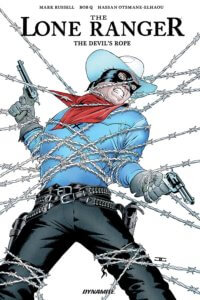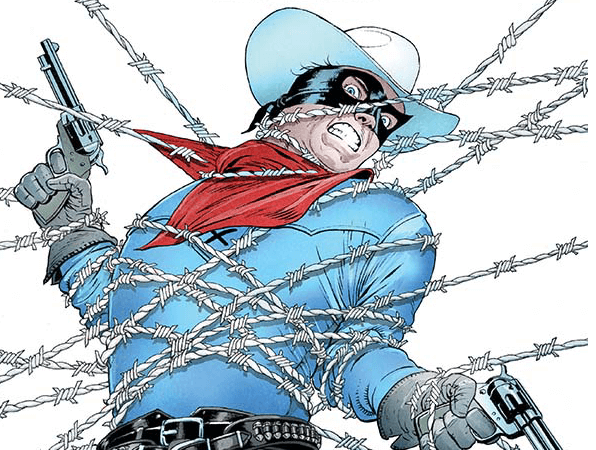The Lone Ranger: The Devil’s Rope
John Cassaday (cover), Hassan Otsmane-Elhaou (letters), Bob Q (colors and art), Mark Russell (writing), Jose Villarubia (cover colors)
September 18th, 2019
Dynamite Comics
“When I heard the shooting I didn’t think too much on it. This was Texas, after all.” – The Lone Ranger
The Lone Ranger is one of those properties that is both extremely familiar as a comic book (multiple comics existed throughout the peak of the character’s fame in the ‘40s and ‘50s) and destined to age poorly (the matter of Tonto has long been an understandably heated and controversial matter in First Nations communities). The Lone Ranger: The Devil’s Rope tries to tug the property into the 2010s while grounding character behavior in the 1800s (the racist characters here are firmly villains).

The plot is simple. A border dispute in Deaf Smith, Texas, reveals a brewing range war—one demarcated by the creation of barbed wire and the introduction of telegraph wires. Ranch owners plan on fencing off their land with barbed wire, then hiring outlaws to kill the native population, government soldiers, and cowboys alike so their bordermaking won’t be challenged.
The Lone Ranger knows he can’t battle these odds alone, and so seeks out Tonto, the First Nations man who saved him from an ambush that killed five other Texas Rangers and has resulted in his being targeted by the ranchers. Out of gratitude and respect, The Lone Ranger has kept a careful distance from the man who helped him, but now calls upon him. The two men reluctantly team up against odds that seem insurmountable—especially when a violent dandy named Connor becomes part of the situation.
The Lone Ranger: The Devil’s Rope takes a spin through the Old West that decontextualizes the cheery old myths that the Lone Ranger’s shows and comics used to serve up to the American public. Instead of being a good ol’ romp, it holds a mirror up to the colonialist, racist, sexist mess that really existed with wit, anger, and honesty—combined with Tonto and the Ranger’s typical teamwork and snarky friendship (yes, they do compete over who has the best plan).
The book handles the problem of Tonto by mocking the old conventions that bound the character in racist and ancient tropes. This is one Tonto who doesn’t speak in halting me-Tarzan-you-Jane-isms. In this version of events, Tonto has been working in a local saloon, sweeping up and clowning for the white racists he disdains so he can survive—using stereotypes of the cheerful, naive native and the drunk Indian to gain the upper hand on his racist competition. He spent time in an industrial school, and has experienced the homogenization of this new West—one of the book’s best scenes involves African-American butlers handing Tonto some incriminating evidence in to his boss, the solidarity between them unspoken but beautifully rendered (and a subplot about the head baddie’s servants rejecting the pain of the past and the memories of slavery to forge a blazing new future for themselves). The book makes its racist characters, thankfully, unambiguous villains, who are also sexist, greedy pigs who want to keep the plantation system in place because they profit from it.

The Ranger’s own personal struggles are handled quite well. The balance between guilt and justice was always strong with him, but here it’s fascinatingly played in that he’s acting against these barons to give room to the unjustly marginalized—very much a key moral for the original Lone Ranger series, but also very different.
That’s not to say that the ride is solely cerebral. It doesn’t give us a lot of colorful, solid action pieces (and flashes of Blazing Saddles-style humor). There are some dynamic panels in this book, all drawn and colored by the inimitable Bob Q, who has since moved on to draw quite well for Dynamite’s Red Sonja franchise and does a wonderful job with the lush colors and beautiful art across this series.
In short, Russell’s writing is fresh and well-rendered and The Lone Ranger: The Devil’s Rope truly surprised me in many ways, from the fresh take on Tonto’s character to the fresh take on life in the Old West, to the way Tonto and The Lone Ranger interact with amusement and bemusement. Well drawn and fascinatingly written, it comes with a recommendation from me.

